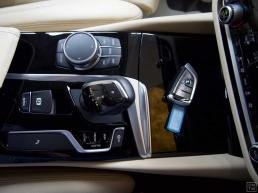The difference between these two cars isn’t just that one is a 3 series, and one is a 5er. No, there’s a generational gap between the two. Driving them back to back gives me deep insight into where BMW’s heading. Read on for more…

Inspite of the model onslaught from the German car companies, the core models still remain the heart of the brands. The 3, 5 and 7 series are important cars for BMW, in the same way that the C, E and S class are important for Mercedes, and the A4, A6 and A8 are important for Audi. It’s true, cars like the X1 and Q3 and A class have generated huge interest overseas, but in their core markets, the bread and butter models are still hugely relevant.

Which makes the 3 & 5 series hugely relevant for BMW, not just in India, but across the world.
BMW produces about 500,000 3 series each year, around the world. Five hundred thousand, for just one car, one model in the range. In comparison, production numbers for the famed X1 stand at about 300,000 a year. For the record, that’s still lower than the 5 series, which clocks in about 350,000 units a year.

Make no mistake then, these are important cars for BMW. Their life depends on them. What’s more, these cars are a definite showcase of where BMW is headed in the future. I’ve got access to the F30 3-series and the G30 5-series for a couple of days, and this article will explore these cars individually, but also try and spot trends on where the BMW model range is headed in the future.

Let’s start with the F30, shall we? The F30 generation is about 6 years old actually. The first car on this platform was released back in 2011. BMW follows a 7 year model replacement strategy, so a new 3 series is around the corner. In fact, the G20 3-series was launched at the Paris Motor Show just a few days back. But I’m going to be focussing on the car that I’m driving right now. I have the 330i variant on tap. This one’s powered by a 2.0 litre 4-cylinder petrol engine that produces 252 bhp. Yes, this is the range topping mainstream petrol on sale in India right now. It makes for quite a quick car. A hundred comes up in about 6 seconds, and if you keep your foot down, the car will go on to an electronically controlled top speed of 250kmph.
But it isn’t the speed itself, it’s the way it’s delivered. For the most part, this is a comfortable, relaxing and refined car. But stomp on the throttle, and you unleash the monster within. It revs to the higher reaches of the tacho, the engine lets out a roar, the traction control kicks in, trying to figure out the amount of grip available and the amount of power to be delivered to the rear wheels. Then of course, you’re pushed back in your seat and you surge ahead. It might sound complicated, this whole process (because it is), but it all happens so quickly. It feels somewhat natural.
I’ve always been a fan of how BMW configures its gearboxes, and the 330i is no exception. Gearshifts are smooth, precise and timely. In fact, in Sport mode, you could rev the nuts of the engine without the gearbox interfering or cutting out the power. It’s deeply satisfying.
Another thing I’m a fan of is how the 3-series handles. It’s tuned well, yes, but it’s also undeniably got less bulk than the 5 or 7 series. Physics imposes some boundaries on what you can do with a car and it’s bulk, but the 3 series feels on cue and in line with the flow of physics. It’s appropriately sized, the steering is quick and nimble, and offers decent feedback. It all adds up to offer a great driving experience. I genuinely enjoyed riving this car around.

I also quite liked the way this F30 looks. There’s a certain nimbleness, a certain lightness to it. It’s sharp, and with the optional M pack it actually looks more planted and more aggressive. BMWs look progressively better as time goes on, and the F30 is a prime example of that. Six years on, it looks absolutely beautiful in the flesh.
I guess the bulk of the car shows a bit when you really push it. Even though it has the same engine under the hood as the 3 series, it feels less nimble. The added weight probably has a lot to do with that, or maybe it’s the fact that this car has been tuned slightly differently. You see, the 2.0L 330i is the range topping M Sport model for India. But the 530i with the 2.0L petrol has a relatively more luxury orientation. In fact, the M sport version actually comes on the diesel variant in India, and not the petrol. The 330i and 530i are very different cars then. One is tuned for being sportier, look sportier (with the M kit), while the other is tuned for comfort, for beating potholes to pieces and & to be chauffeured around in. At that, the 530i does a commendable job.

One is tuned for being sportier, look sportier (with the M kit), while the other is tuned for comfort, for beating potholes to pieces and & to be chauffeured around in. At that, the 530i does a commendable job.
But what about the differences between the 330i and 530i? For starters, the 530i is significantly bigger than the 330i. It’s also bigger than the outgoing 5-series. That could signal that the next generation of BMWs are going to increase in size. The new 5-series comes kitted with a lot more kit for India, even on the base version. Digital dials, bigger iDrive screen, Gesture control etc. This could be a sign of things to come too. You’d see this generation of BMWs get more high tech than ever before. More bang for you buck I guess!
Time will tell how these changes change the character of the individual cars, but there’s a lot to look forward to if you, like me, are a BMW aficionado.












